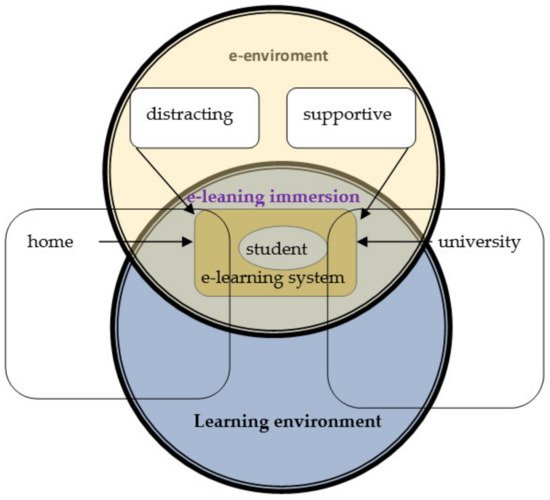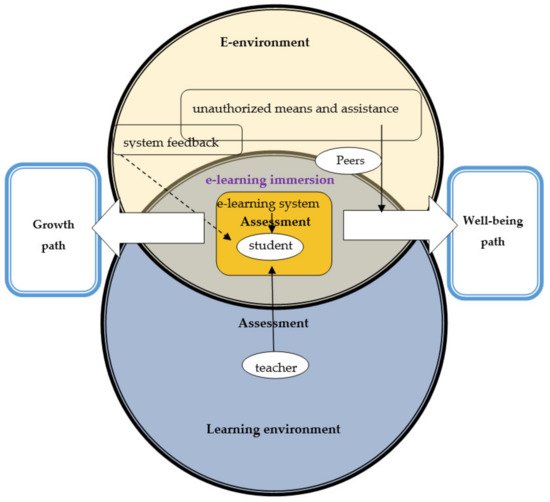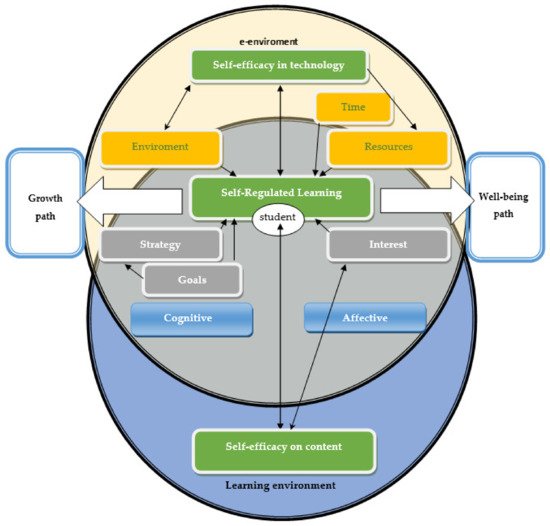
| Version | Summary | Created by | Modification | Content Size | Created at | Operation |
|---|---|---|---|---|---|---|
| 1 | Daria Bylieva | + 2514 word(s) | 2514 | 2021-12-08 03:37:40 | | | |
| 2 | Bruce Ren | Meta information modification | 2514 | 2022-01-12 01:51:39 | | |
Video Upload Options
The COVID-19 pandemic has contributed to the accelerated spread of e-learning around the world. In e-learning, self-regulation becomes more relevant than ever. Reducing the influence of traditional features of the face-to-face learning environment and increasing the impact of the e-environment place high demands on students’ self-regulation. The author’s self-regulation e-learning model emphasizes the position of e-learning at the intersection of the electronic environment and the learning environment.
1. Introduction
-Self-determination (competency, autonomy, and relatedness) [34][35];
-Self-regulation [36][37][38][39] that associated with planning, management, and control of the learning process [40];
-Self-discipline [26];
-Self-efficacy [41][42][43][44] that is associated with self-directed behavior and autonomy [45] or students’ confidence in their abilities to successfully fulfill educational requirements [46];
-Emotional intelligence [47].
2. Self-Regulated Learning Model
3. Self-Regulated Learning Models in E-Learning



References
- Zhang, W.; Wang, Y.; Yang, L.; Wang, C. Suspending classes without stopping learning: China’s education emergency management policy in the COVID-19 outbreak. J. Risk Financ. Manag. 2020, 13, 55.
- Rubtsova, A.; Odinokaya, M.; Krylova, E.; Smolskaia, N. Problems of Mastering and Using Digital Learning Technology in the Context of a Pandemic. In Knowledge in the Information Society; PCSF 2020, CSIS 2020; Lecture Notes in Networks and Systems; Springer: Cham, Switzerland, 2021; Volume 184, pp. 324–337.
- Alsoud, A.R.; Harasis, A.A. The Impact of COVID-19 Pandemic on Student’s E-Learning Experience in Jordan. J. Theor. Appl. Electron. Commer. Res. 2021, 16, 79.
- Almazova, N.; Krylova, E.; Rubtsova, A.; Odinokaya, M. Challenges and Opportunities for Russian Higher Education amid COVID-19: Teachers’ Perspective. Educ. Sci. 2020, 10, 368.
- Valieva, F.; Fomina, S.; Nilova, I. Distance Learning during the Corona-Lockdown: Some Psychological and Pedagogical Aspects. In Knowledge in the Information Society; PCSF 2020, CSIS 2020; Bylieva, D., Nordmann, A., Shipunova, O., Volkova, V., Eds.; Lecture Notes in Networks and Systems; Springer: Cham, Switzerland, 2021; Volume 184, pp. 289–300.
- Pokrovskaia, N.N.; Tyulin, A.T. Psychological Features of the Regulative Mechanisms Emerging in the Digital Space. Technol. Lang. 2021, 2, 106–125.
- Samorodova, E.A.; Belyaeva, I.G.; Bakaeva, S.A. Analysis of communicative methods effectiveness in teaching foreign languages during the coronavirus epidemic: Distance format. XLinguae 2021, 14, 131–140.
- Amarneh, B.M.; Alshurideh, M.T.; Al Kurdi, B.H.; Obeidat, Z. The Impact of COVID-19 on E-learning: Advantages and Challenges. In Proceedings of the International Conference on Artificial Intelligence and Computer Vision (AICV2021); Hassanien, A.E., Haqiq, A., Tonellato, P.J., Bellatreche, L., Goundar, S., Azar, A.T., Sabir, E., Bouzidi, D., Eds.; Advances in Intelligent Systems and Computing; Springer: Cham, Switzerland, 2021; Volume 1377, pp. 75–89.
- Meder, C. Counselor Education Delivery Modalities: Do They Affect Student Learning Outcomes? Ph.D. Thesis, Regent University, Virginia Beach, VA, USA, May 2013. Database 2013 UMI Number: 357359.
- Lyke, J.; Frank, M. Comparison of student learning outcomes in online and traditional classroom environments in a psychology course. J. Instr. Psychol. 2012, 39, 245–250.
- Waschull, S.B. The Online Delivery of Psychology Courses: Attrition, Performance, and Evaluation. Teach. Psychol. 2001, 28, 143–147.
- Wallace, P.E.; Clariana, R.B. Achievement predictors for a computer-applications module delivered online. J. Inf. Syst. Educ. 2020, 11, 3.
- Upton, D.; Cooper, C.D. Online Health Psychology: Do Students Need It, Use It, Like It and Want It? Psychol. Learn. Teach. 2004, 3, 27–35.
- Xu, D.; Jaggars, S.S. The effectiveness of distance education across Virginia’s community colleges: Evidence from introductory college-level math and English courses. Educ. Eval. Policy Anal. 2011, 33, 360–377.
- Moore, J.C.; Fetzner, M.J. The road to retention: A closer look at institutions that achieve high course completion rate. J. Asynchronous Learn. Netw. 2009, 13, 3–22.
- Njenga, J.K.; Fourie, L.C.H. The myths about e-learning in higher education. Br. J. Educ. Technol. 2010, 41, 199–212.
- Patterson, B.; McFadden, C. Attrition in Online and Campus Degree Programs. Online J. Distance Learn. Adm. 2009, 12. Available online: https://www.westga.edu/~distance/ojdla/summer122/patterson112.html (accessed on 16 October 2021).
- Holder, B. An investigation of hope, academics, environment, and motivation as predictors of persistence in higher education online programs. Internet High. Educ. 2007, 10, 245–260.
- Rodriguez, V.P. Relationships between Student Characteristics and Student Persistence in Online Classes at a Community College (Order No. 3485377). Ph.D. Thesis, University of California, Long Beach, CA, USA, May 2011.
- Palmer, S. Understanding the context of distance students: Differences in on- and off- campus engagement with an online learning environment. J. Open Flex. Distance Learn. 2012, 16, 70–82.
- Van Doorn, J.R.; Van Doorn, J.D. The quest for knowledge transfer efficacy: Blended teaching, online and in-class, with consideration of learning typologies for non-traditional and traditional students. Front. Psychol. 2014, 5, 324.
- Neff, K.S.; Donaldson, S.I. Teaching Psychology Online: Tips and Strategies for Success; Psychology Press: New York, NY, USA, 2013.
- Bowers, J.; Kumar, P. Students’ Perceptions of Teaching and Social Presence. Int. J. Web-Based Learn. Teach. Technol. 2015, 10, 27–44.
- Appana, S. A review of benefits and limitations of line learning in the context of the student, the instructor, and the tenured faculty. Int. J. E-Learn. 2008, 7, 5–22.
- Song, H.; Kim, J.; Park, N. I Know My Professor: Teacher Self-Disclosure in Online Education and a Mediating Role of Social Presence. Int. J. Hum.-Comput. Interact. 2019, 35, 448–455.
- Gaytan, J. Factors Affecting Student Retention in Online Courses: Overcoming this Critical Problem. Career Tech. Educ. Res. 2013, 38, 145–155.
- Wuensch, K.L.; Aziz, S.; Ozan, E.; Kinshore, M.; Tabrizi, M.H.N. Pedagogical characteristics of online and face-to-face classes. Int. J. E-Learn. 2008, 7, 523–532.
- Bylieva, D.; Moccozet, L. Technology-Mediated Communication for Educational Purposes (in Russia and Switzerland). Technol. Lang. 2021, 2, 75–88.
- Dewan, M.A.A.; Murshed, M.; Lin, F. Engagement detection in online learning: A review. Smart Learn. Environ. 2019, 6, 1.
- Shah, M.; Cheng, M. Exploring factors impacting student engagement in open access courses. Open Learn. J. Open Distance E-Learn. 2019, 34, 187–202.
- Christenson, S.; Reschly, A.; Wylie, C. Handbook of Research on Student Engagement; Springer: New York, NY, USA, 2012.
- Floratos, N.; Guasch, T.; Espasa, A. Recommendations on Formative Assessment and Feedback Practices for stronger engagement in MOOCs. Open Prax. 2015, 7, 141–152.
- Al-Hendawi, M. Academic engagement of students with emotional and behavioral disorders: Existing research, issues, and future directions. Emot. Behav. Difficulties 2012, 17, 125–141.
- Chen, K.; Jang, S. Motivation in online learning: Testing a model of self-determination theory. Comput. Hum. Behav. 2010, 26, 741–752.
- Nichols, M. Student perceptions of support services and the influence of targeted interventions on retention in distance education. Distance Educ. 2010, 31, 93–113.
- Gomez, D. Leadership behavior and its impact on student success and retention in online graduate education. Acad. Educ. Leadersh. J. 2013, 17, 13–37.
- Artino, A.R. Promoting academic motivation and self-regulation: Practical guidelines for online instruction. TechTrends 2008, 52, 37–45.
- Wladis, C.; Hachey, A.C.; Conway, K. An investigation of course-level factors as predictors of online STEM course outcomes. Comput. Educ. 2014, 77, 145–150.
- Lung-Guang, N. Decision-making determinants of students participating in MOOCs: Merging the theory of planned behavior and self-regulated learning model. Comput. Educ. 2019, 134, 50–62.
- Kizilcec, R.F.; Pérez-Sanagustín, M.; Maldonado, J.J. Self-regulated learning strategies predict learner behavior and goal attainment in Massive Open Online Courses. Comput. Educ. 2017, 104, 18–33.
- Leasure, A.; Davis, L.; Thievon, S. Comparison of student outcomes and preferences in a traditional vs. World Wide Web-based baccalaureate nursing research course. J. Nurs. Educ. 2000, 39, 149–154.
- Gaytan, J. Comparing Faculty and Student Perceptions Regarding Factors That Affect Student Retention in Online Education. Am. J. Distance Educ. 2015, 29, 56–66.
- Ormrod, J.E. Social cognitive views of learning. In Educational Psychology: Developing Learners; Smith, P.A., Ed.; Pearson: Boston, MA, USA, 2011; pp. 352–354.
- Tladi, L.S. Perceived ability and success: Which self-efficacy measures matter? A distance learning perspective. Open Learn. J. Open Distance E-Learn. 2017, 32, 243–261.
- Liaw, S. Investigating students’ perceived satisfaction, behavioral intention, and effectiveness of e-learning: A case study of the Blackboard system. Comput. Educ. 2008, 51, 864–873.
- Gore, P.A., Jr. Academic self-efficacy as a predictor of college outcomes: Two incremental validity studies. J. Career Assess. 2006, 14, 92–115.
- Berenson, R.; Boyles, G.; Weaver, A. Emotional Intelligence as a Predictor of Success in Online Learning. Int. Rev. Res. Open Distrib. Learn. 2008, 9.
- Gallagher, S. Distance Learning at the Tipping Point: Critical Success Factors to Growing Fully Online Distance Learning Programs; Eduventures, Inc.: Boston, MA, USA, 2002.
- Safford, K.; Stinton, J. Barriers to blended digital distance vocational learning for non-traditional students. Br. J. Educ. Technol. 2016, 47, 135–150.
- Shaw, M.; Burrus, S.; Ferguson, K. Factors that influence student attrition in online courses. Online J. Distance Learn. Adm. 2016, 19, 211–231.
- Ware, J. Earning an MBA online: Internet-based programs offer flexibility. Fla. Trend 2014, 56, 84.
- Leeds, E.; Campbell, S.; Baker, H.; Ali, R.; Brawley, D.; Crisp, J. The impact of student retention strategies: An empirical study. Int. J. Manag. Educ. 2013, 7, 22.
- Rochester, C.D.; Pradel, F. Students’ Perceptions and Satisfaction with a Web-Based Human Nutrition Course. Am. J. Pharm. Educ. 2008, 72, 91.
- Inzlicht, M.; Werner, K.M.; Briskin, J.L.; Roberts, B.W. Integrating Models of Self-Regulation. Annu. Rev. Psychol. 2021, 72, 319–345.
- Boekaerts, M.; Corno, L. Self-Regulation in the Classroom: A Perspective on Assessment and Intervention. Appl. Psychol. 2005, 54, 199–231.
- Asarnow, J.R.; Meichenbaum, D. Verbal Rehearsal and Serial Recall: The Mediational Training of Kindergarten Children. Child Dev. 1979, 50, 1173–1177.
- Mahoney, M.J.; Thoresen, C.E. Behavioral Self-Control: Power to the Person. Educ. Res. 1972, 1, 5–7.
- Bandura, A. Social Foundations of Thought and Action: A Social Cognitive Theory; Prentice Hall: Englewood Cliffs, NJ, USA, 1986.
- Zimmerman, B.J.; Schunk, D.H. Self-Regulated Learning and Performance. In Handbook of Self-Regulation of Learning and Performance; Zimmerman, B.J., Schunk, D.H., Eds.; Routledge: New York, NY, USA, 2011; pp. 1–12.
- Akamatsu, D.; Nakaya, M.; Koizumi, R. Effects of Metacognitive Strategies on the Self-Regulated Learning Process: The Mediating Effects of Self-Efficacy. Behav. Sci. 2019, 9, 128.
- Boekaerts, M.; Pintrich, P.R.; Zeidner, M. Self-Regulation: An Introductory Overview. In Handbook of Self-Regulation; Boekaerts, M., Zeidner, M., Pintrich, P.R., Eds.; Elsevier: San Diego, CA, USA, 2000; pp. 1–9.
- Zimmerman, B.J. A social cognitive view of self-regulated academic learning. J. Educ. Psychol. 1989, 81, 329–339.
- Zimmerman, B.J. From Cognitive Modeling to Self-Regulation: A Social Cognitive Career Path. Educ. Psychol. 2013, 48, 135–147.
- Odinokaya, M.; Krepkaia, T.; Karpovich, I.; Ivanova, T. Self-Regulation as a Basic Element of the Professional Culture of Engineers. Educ. Sci. 2019, 9, 200.
- Puzziferro, M. Online Technologies Self-Efficacy and Self-Regulated Learning as Predictors of Final Grade and Satisfaction in College-Level Online Courses. Am. J. Distance Educ. 2008, 22, 72–89.
- Paris, S.G.; Paris, A.H. Classroom Applications of Research on Self-Regulated Learning. Educ. Psychol. 2001, 36, 89–101.
- Pintrich, P.R. The role of goal orientation in self-regulated learning. In Handbook of Self-Regulation; Boekaerts, M., Pintrich, P.R., Zeidner, M., Eds.; Academic Press: San Diego, CA, USA, 2000; pp. 452–502.
- Bandura, A.; Cervone, D. Differential engagement of self-reactive influences in cognitive motivation. Organ. Behav. Hum. Decis. Process. 1986, 38, 92–113.
- Panadero, E. A Review of Self-regulated Learning: Six Models and Four Directions for Research. Front. Psychol. 2017, 8, 422.
- Zimmerman, B.J.; Schunk, H.D. Self-Regulated Learning and Academic Achievement: Theoretical Perspectives, 2nd ed.; Routledge: Abingdon, UK, 2008; ISBN 0-0858-3560-1.
- Zimmerman, B.J.; Moylan, A.R. Self-regulation: Where metacognition and motivation intersect. In Handbook of Metacognition in Education; Hacker, D.J., Dunlosky, J., Graesser, A.C., Eds.; Routledge: New York, NY, USA, 2009; pp. 299–315.
- Sadi, Ö.; Uyar, M. The relationship between self-efficacy, self-regulated learning strategies and achievement: A path model. J. Balt. Sci. Educ. 2013, 12, 21–33.
- Roick, J.; Ringeisen, T. Students’ math performance in higher education: Examining the role of self-regulated learning and self-efficacy. Learn. Individ. Differ. 2018, 65, 148–158.
- Alghamdi, A.; Karpinski, A.C.; Lepp, A.; Barkley, J. Online and face-to-face classroom multitasking and academic performance: Moderated mediation with self-efficacy for self-regulated learning and gender. Comput. Hum. Behav. 2020, 102, 214–222.
- Moghadari-Koosha, M.; Moghadasi-Amiri, M.; Cheraghi, F.; Mozafari, H.; Imani, B.; Zandieh, M. Self-Efficacy, Self-Regulated Learning, and Motivation as Factors Influencing Academic Achievement Among Paramedical Students: A Correlation Study. J. Allied Health 2020, 49, 145E–152E.
- Greene, J.A.; Plumley, R.D.; Urban, C.J.; Bernacki, M.L.; Gates, K.M.; Hogan, K.A.; Demetriou, C.; Panter, A.T. Modeling temporal self-regulatory processing in a higher education biology course. Learn. Instr. 2019, 72, 101201.
- Boekaerts, M.; Rozendaal, J.S. Self-regulation in Dutch secondary vocational education: Need for a more systematic approach to the assessment of self-regulation. In Zeitschrift für Berufs- und Wirtschaftspädagogik; Euler, D., Lang, M., Pätzold, G., Eds.; Franz Steiner: Stuttgart, Germany, 2006.
- Boekaerts, M. Emotions, emotion regulation, and self-regulation of learning. In Handbook of Self-Regulation of Learning and Performance; Zimmerman, B.J., Schunk, D.H., Eds.; Routledge: New York, NY, USA, 2011; pp. 408–425.
- Shea, P.; Bidjerano, T. Learning presence: Towards a theory of self-efficacy, self-regulation, and the development of a communities of inquiry in online and blended learning environments. Comput. Educ. 2010, 55, 1721–1731.
- Cho, M.-H.; Shen, D. Self-regulation in online learning. Distance Educ. 2013, 34, 290–301.
- Lee, D.; Watson, S.L.; Watson, W.R. Systematic literature review on self-regulated learning in massive open online courses. Australas. J. Educ. Technol. 2019, 35.
- Artino, A.R.; Jones, K.D. Exploring the complex relations between achievement emotions and self-regulated learning behaviors in online learning. Internet High. Educ. 2012, 15, 170–175.
- Bruso, J.L.; Stefaniak, J.E. The Use of Self-Regulated Learning Measure Questionnaires as a Predictor of Academic Success. TechTrends 2016, 60, 577–584.
- Barnard, L.; Lan, W.Y.; To, Y.M.; Paton, V.O.; Lai, S.-L. Measuring self-regulation in online and blended learning environments. Internet High. Educ. 2009, 12, 1–6.
- Broadbent, J.; Poon, W.L. Self-regulated learning strategies & academic achievement in online higher education learning environments: A systematic review. Internet High. Educ. 2015, 27, 1–13.
- Suárez Monzón, N.; Jadán-Guerrero, J.; Almeida, R.R.; Valdivieso, K.E.D. E-learning Ergonomic Challenges during the Covid-19 Pandemic. In Advances in Human Factors in Training, Education, and Learning Sciences; Springer: Cham, Swizerland, 2021; pp. 324–330.
- Lopes, A.P.; Soares, F. Interactive Learning Materials Contribution for Students’ Engagement in E-Learning of Mathematics Contents: A Case Study during the Covid-19 Pandemic. In Proceedings of the 15th International Technology, Education and Development Conference (INTED 2021), Valencia, Spain, 8–9 March 2021; pp. 329–335.
- Saleem, M.; Kamarudin, S.; Shoaib, H.M.; Nasar, A. Influence of augmented reality app on intention towards e-learning amidst COVID-19 pandemic. Interact. Learn. Environ. 2021, 1–15.
- Alfarsi, G.; Yusof, A.B.M.; Tawafak, R.M.; Malik, S.I.; Mathew, R.; Ashfaque, M.W. Instructional Use of Virtual Reality in E-Learning Environments. In Proceedings of the 2020 IEEE International Conference on Advent Trends in Multidisciplinary Research and Innovation (ICATMRI), Buldhana, India, 30 December 2020; pp. 1–5.
- Zaidi, S.F.H.; Osmanaj, V.; Ali, O.; Zaidi, S.A.H. Adoption of mobile technology for mobile learning by university students during COVID-19. Int. J. Inf. Learn. Technol. 2021, 38, 329–343.
- Shipunova, O.; Pozdeeva, E.; Evseeva, L.; Mureyko, L.V. Young Students’ Attitude toward Expert Knowledge. In Knowledge in the Information Society; PCSF 2020, CSIS 2020; Bylieva, D., Nordmann, A., Shipunova, O., Volkova, V., Eds.; Lecture Notes in Networks and Systems; Springer: Cham, Switzerland, 2021; Volume 184, pp. 391–400.
- Herdian, H.; Mildaeni, I.N.; Wahidah, F.R. “There are Always Ways to Cheat” Academic Dishonesty Strategies during Online Learning. J. Learn. Theory Methodol. 2021, 2, 60–67.
- Golden, J.; Kohlbeck, M. Addressing cheating when using test bank questions in online Classes. J. Account. Educ. 2020, 52, 100671.
- Bylieva, D.; Zamorev, A.; Lobatyuk, V.; Anosova, N. Ways of Enriching MOOCs for Higher Education: A Philosophy Course. In Knowledge in the Information Society; PCSF 2020, CSIS 2020; Bylieva, D., Nordmann, A., Shipunova, O., Volkova, V., Eds.; Lecture Notes in Networks and Systems; Springer: Cham, Switzerland, 2021; Volume 184, pp. 338–351.
- Bylieva, D.; Lobatyuk, V.; Tolpygin, S.; Rubtsova, A. Academic dishonesty prevention in e-learning university system. In Trends and Innovations in Information Systems and Technologies, Proceedings of the 8th World Conference on Information Systems and Technologies, Budva, Montenegro, 7–10 April 2020; Rocha, A., Adeli, H., Reis, L.P., Costanzo, S., Orovic, I., Moreira, F., Eds.; Advances in Intelligent Systems and Computing; Springer: Cham, Switzerland, 2020; Volume 1161, pp. 225–234.
- Caingcoy, M.E.; Lepardo, R.J.L. School Performance, Leadership and Core Behavioral Competencies of School Heads: Does Higher Degree Matter? J. Adv. Soc. Sci. Humanit. 2020, 6, 1190–1196.
- Pozdeeva, E.; Shipunova, O.; Popova, N.; Evseev, V.; Evseeva, L.; Romanenko, I.; Mureyko, L. Assessment of Online Environment and Digital Footprint Functions in Higher Education Analytics. Educ. Sci. 2021, 11, 256.
- Berezovskaya, I.; Shipunova, O.; Kedich, S.; Popova, N. Affective and Cognitive Factors of Internet User Behaviour. In Knowledge in the Information Society; PCSF 2020, CSIS 2020; Bylieva, D., Nordmann, A., Shipunova, O., Volkova, V., Eds.; Lecture Notes in Networks and Systems; Springer: Cham, Switzerland, 2021; Volume 184, pp. 38–49.
- ChanLin, L.-J. Learning strategies in web-supported collaborative project. Innov. Educ. Teach. Int. 2012, 49, 319–331.




